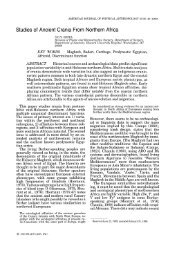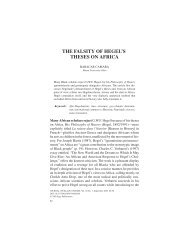Dutch Slavery and Slave Trade in the Indian Ocean
Dutch Slavery and Slave Trade in the Indian Ocean
Dutch Slavery and Slave Trade in the Indian Ocean
Create successful ePaper yourself
Turn your PDF publications into a flip-book with our unique Google optimized e-Paper software.
176 journal of world history, june 2003<br />
Conclusion<br />
Follow<strong>in</strong>g <strong>the</strong> discovery of <strong>the</strong> seasonal monsoon regime sometime<br />
after 300 b.c.e., <strong>the</strong> societies <strong>and</strong> cultures of <strong>the</strong> <strong>Indian</strong> <strong>Ocean</strong> bas<strong>in</strong><br />
became <strong>in</strong>tegrated <strong>in</strong> a regional world-system. As <strong>the</strong> world’s oldest<br />
trade, traffick<strong>in</strong>g <strong>in</strong> captive labor <strong>in</strong>volved, among o<strong>the</strong>r th<strong>in</strong>gs, <strong>the</strong><br />
migration of peoples, cultural diffusion, <strong>and</strong> economic exchange.<br />
Arriv<strong>in</strong>g <strong>in</strong> <strong>the</strong> <strong>Indian</strong> <strong>Ocean</strong> <strong>in</strong> <strong>the</strong> late sixteenth century, <strong>the</strong> <strong>Dutch</strong><br />
took over <strong>and</strong> <strong>in</strong>teracted with preexist<strong>in</strong>g systems of slavery <strong>and</strong> dependency.<br />
Like its <strong>Indian</strong> <strong>Ocean</strong> predecessor, <strong>the</strong> <strong>Dutch</strong> <strong>Indian</strong> <strong>Ocean</strong><br />
slave trade was urban-centered, draw<strong>in</strong>g captive labor from three <strong>in</strong>terlock<strong>in</strong>g<br />
<strong>and</strong> overlapp<strong>in</strong>g circuits or subregions: “Greater South Africa,”<br />
South Asia, <strong>and</strong> Sou<strong>the</strong>ast Asia. <strong>Dutch</strong> slavery discourse was rendered<br />
<strong>in</strong> religious humanitarian terms. Private <strong>and</strong> company slaves served as<br />
general laborers <strong>and</strong> were used <strong>in</strong> a wide variety of occupations <strong>in</strong> <strong>the</strong><br />
<strong>Dutch</strong> settlements across <strong>the</strong> <strong>Indian</strong> <strong>Ocean</strong> bas<strong>in</strong>. In certa<strong>in</strong> of <strong>the</strong>se<br />
slave societies, however, <strong>the</strong>y also performed specific activities <strong>in</strong><br />
accordance with <strong>the</strong> size of <strong>the</strong> <strong>in</strong>dividual slave household <strong>and</strong> <strong>the</strong><br />
particular position <strong>the</strong> settlement occupied with<strong>in</strong> <strong>the</strong> company’s overall<br />
commercial network. The division of slave labor roughly followed<br />
ethnic, gender, <strong>and</strong> age l<strong>in</strong>es based on colonial taxonomy <strong>and</strong> preexist<strong>in</strong>g<br />
<strong>in</strong>digenous beliefs <strong>and</strong> practices that characterized local slave systems.<br />
The number of company <strong>and</strong> total <strong>Dutch</strong> slaves <strong>and</strong> <strong>the</strong> accompany<strong>in</strong>g<br />
volume of <strong>the</strong> annual slave trades fluctuated greatly. In <strong>the</strong> late<br />
seventeenth century, <strong>the</strong>re were about 4,000 company slaves <strong>and</strong> perhaps<br />
60,000 total slaves. In order to replenish <strong>the</strong>se numbers, 200–400<br />
company slaves <strong>and</strong> 3,200–5,600 total slaves had to be imported each<br />
year. Assum<strong>in</strong>g an average mortality rate en route of 20%, 240–480<br />
company slaves <strong>and</strong> 4,476–7,716 total <strong>Dutch</strong> slaves had to be exported<br />
from <strong>the</strong>ir respective catchment areas. While slave revolt was rare,<br />
slave resistance assumed a variety of everyday forms of resistance, especially<br />
desertion or maroonage.<br />
Recent Afrocentric archival research has cast new light on <strong>the</strong><br />
world’s oldest trade <strong>in</strong> <strong>the</strong> <strong>Indian</strong> <strong>Ocean</strong> bas<strong>in</strong>, especially <strong>the</strong> east<br />
coast of Africa (after 1770) <strong>and</strong> <strong>the</strong> <strong>Dutch</strong> Cape Colony (1652–1796/<br />
1805). Effectively end<strong>in</strong>g <strong>the</strong> protracted history of silence, <strong>the</strong> suffer<strong>in</strong>g<br />
of <strong>the</strong> <strong>Indian</strong> <strong>Ocean</strong> slaves is f<strong>in</strong>ally be<strong>in</strong>g noted by contemporary<br />
historians. Fur<strong>the</strong>r Asian-centric research, however, is needed to map<br />
this previously uncharted territory <strong>in</strong> greater detail, <strong>in</strong> particular for<br />
<strong>the</strong> period before 1770 <strong>and</strong> for <strong>the</strong> areas east of <strong>the</strong> southwest <strong>Indian</strong><br />
<strong>Ocean</strong>. A more comprehensive chronological <strong>and</strong> geographic cover-




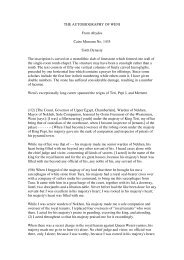
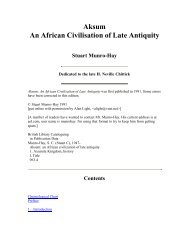
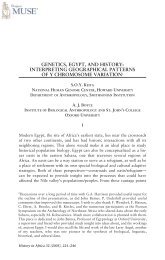

![The Negro trail blazers of California [microform] : a ... - Homestead](https://img.yumpu.com/32436613/1/174x260/the-negro-trail-blazers-of-california-microform-a-homestead.jpg?quality=85)

